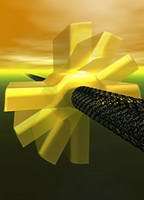Unique Electrochromic Windows and Synthetic Nanomotor Win 'The Oscars of Technology'

A unique new type of energy-saving electrochromic window and the smallest synthetic motor ever reported, both of which were developed by scientists at the U.S. Department of Energy’s Lawrence Berkeley National Laboratory (Berkeley Lab), have been recognized with 2004 Research and Development 100 Awards. Given by Research and Development Magazine, the awards have been called “the Oscars of technology.” The addition of these two winners brings the total of Research and Development 100 Awards won by Berkeley Lab researchers to 34.
Each year since 1963, R&D Magazine has honored the "100 most technologically significant new products and advancements over the past year" from the entries the magazine receives. The chief criterion for winning the award is the potential to “change people's lives for the better.”
Of the R&D 100 Awards won by Berkeley Lab this year, one went to Transition Metal Switchable Mirrors, a technology for coating a glass surface with a thin film made from an alloy of magnesium and one or more transition metals, such as nickel or manganese. This film enables the glass to be reversibly converted from a reflecting to a transparent surface through either an electrical charge or exposure to hydrogen gas. As the film can be programmed to respond to sunlight passing through a glass window, its wide use represents billions of dollars that could be save each year. The heating and cooling lost through windows are estimated to cost U.S. consumers about $9.3 billion annually.
The switchable mirrors technology was invented by Tom Richardson and Jonathan Slack, of Berkeley Lab’s Environmental Energy Technologies Division. By using transition metals rather than the rare earth metals used in the current crop of electrochromic windows, Richardson and Slack were able to significantly lower the costs of the windows, as well as add the capability to reflect and absorb both visible and infrared light. Among the possible applications of this technology, in addition to glass windows in buildings, are sunroofs and space missions. Already, Richardson and Slack are working with two major window companies to get the switchable mirrors to the marketplace.

The other award-winning technology won’t be available on the market any time soon, but its enormous potential stands in stark contrast to its incredibly tiny size. Called a “synthetic rotational nanomotor,” this device was constructed under the leadership of physicist Alex Zettl, who holds a joint appointment with Berkeley Lab’s Materials Sciences Division and the University of California’s Berkeley campus. The first nanomotor Zettl and his colleagues built consisted of a gold paddle-shaped rotor blade, measuring between 100 and 300 nanometers in length, that was connected to a carbon nanotube shaft less than 10 nanometers thick. This first motor was about 300 times smaller than the diameter of a human hair, and the technology behind it allows for future versions to be made even smaller – perhaps as much as five times smaller.
The synthetic rotational nanomotor has been clocked at 33,000 cycles per second and is believed to be capable of speeds approaching one billion rotations per second. Because the carbon and carbon bonds connecting the rotor blade to the shaft are practically frictionless, the motor can run indefinitely without wearing down. It is also rugged enough to withstand the harshest of environmental conditions, including extreme temperatures and radiation.
Potential applications of the nanomotor technology include bio and environmental sensors, cell phones, PDAs, optics, airbags, tire sensors, digital pens, blood pressure monitors, extremely “smart” sub-woofers and antenna alignment. The technology should also find a broad range of applications in the field of cosmology for the exploration of deep space.
Berkeley Lab’s R&D 100 Award-winning technologies were nominated by the Laboratory’s Technology Transfer Department. All winners of the 2004 award will receive a plaque at R&D Magazine’s annual awards banquet in October and a write-up in both the print and online version of the magazine.
Berkeley Lab is a U.S. Department of Energy national laboratory located in Berkeley, California. It conducts unclassified scientific research and is managed by the University of California. Visit our Website at www.lbl.gov/.
Additional Information
More information about the Transition Metal Switchable Mirrors
More information about the synthetic rotational nanomotor
More information about Berkeley Lab’s Technology Transfer Department
Source: Berkeley Lab


















